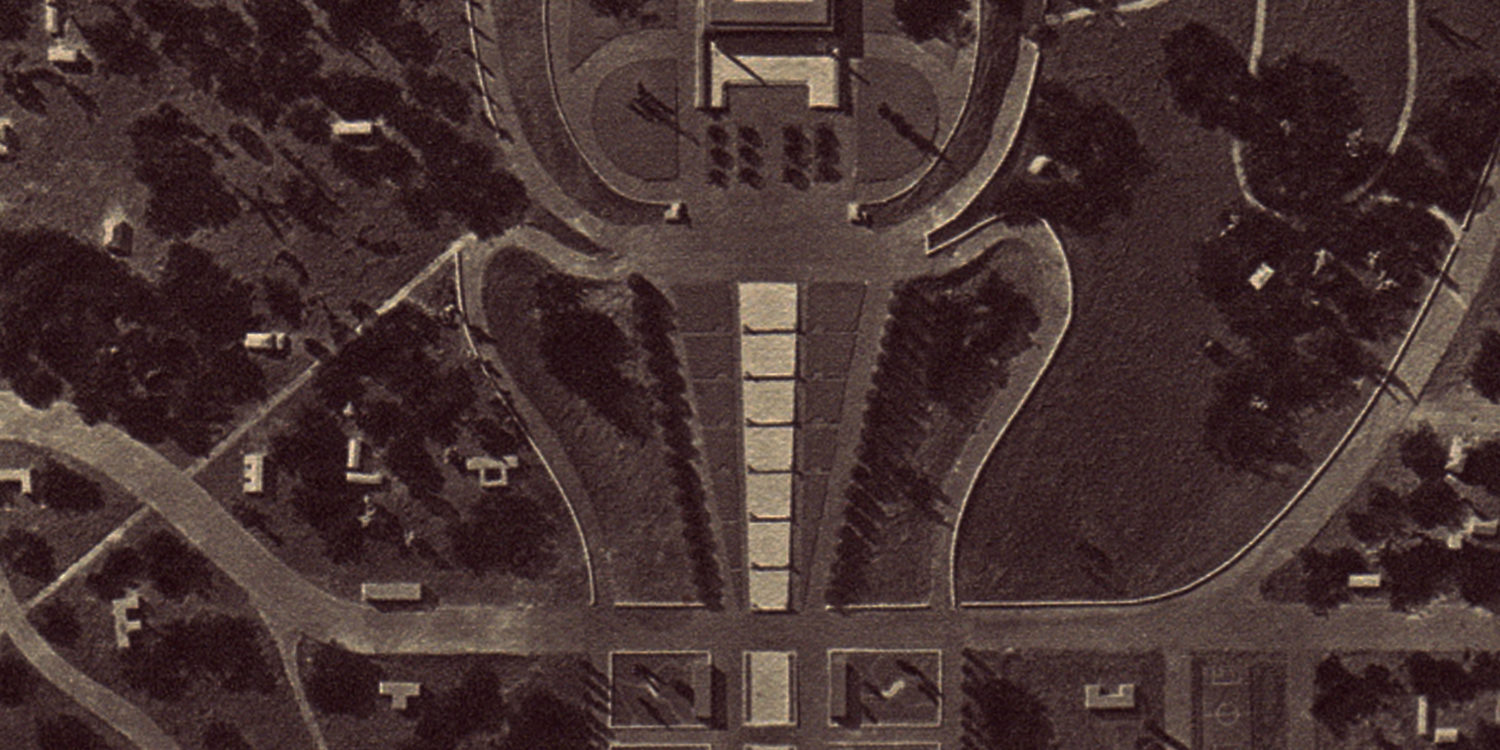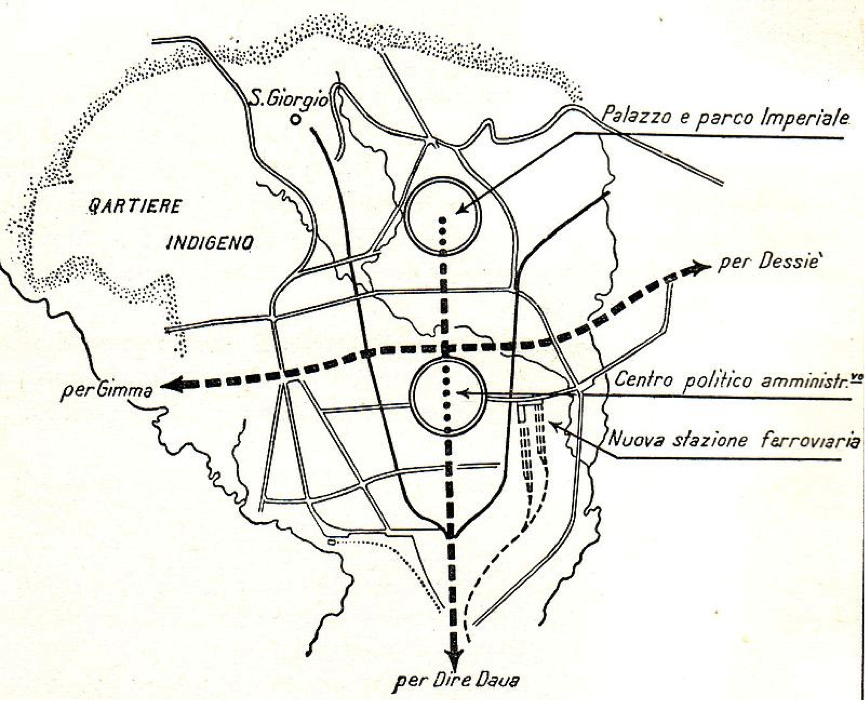Had Le Corbusier’s sketch for the colonial capital of Addis Ababa been realized, it would have been one of the most ruthlessly planned cities of the twentieth century. On the 19th of August 1936 (a mere three months after the conquest of Addis Ababa), Le Corbusier wrote to Mussolini to offer his technical services and to comment on the appropriate design for the new cities of Africa Orientale Italiana, the Italian colonial empire. The design, which accompanied the letter, would show “how a city for modern times is born”, as the famous architect put it.
Like other Italian architects occupied with the designs for the new empire, Le Corbusier considered Ethiopia to be an architectural playground. The new country, considered by Mussolini’s architects to be a ‘virgin territory’ waiting to be transformed into Italian territory, was nothing less than the articulation of the ultimate ability to plan a society. Perhaps the colonial environment provided the ideal circumstances to create and test new ideas – successfully or not – on how to shape new environments for living while acting as a testing ground for European architects and urban planners to realize their experiments away from the constrictions of the fatherland.
The reality was, however, somewhat different. Ethiopia was anything but a blank slate. Addis Ababa had been the capital of the Ethiopian empire since 1889 and was a full-grown city concentrated around the imperial palace of Menelik II. This little known sketch for the town in the Italian colonial empire in Africa, made in 1936, therefore not only presents radically new ideas on colonial urbanism, but also serves as a testing ground for the critical relationship between ‘theory and practice’. The sketch can also be used to think about several questions: how were ideas about urbanism and political, social and economic agenda’s translated into the final building plan? How were radical utopian ideas on the city of the future were translated into concrete form? How did architects mediate between a ‘virgin territory’ and an irrevocable reality?
The idea of Ethiopia as a tabula rasa—a blank slate—was omnipresent in the writings of architects and urban planners occupied with the designs of the colonial capital between 1936 and 1939, who considered the country devoid of any structures of architectural significance. Contrary to the fascination of Libyan whitewashed courtyard house – their simplicity, colours and volumes perfectly in tune with modern taste – the round houses of the Ethiopians were regarded by Italian architects as irrational and unhygienic.
Carlo Enrico Rava, an architect working in Libya, wrote in an article in 1931–six years before the opposing view was stated about Ethiopia—stating that architecture in Libya was “perfectly overwhelmingly Rational… no element is superfluous…it fully satisfies our modern aesthetic,” . The newly proclaimed empire was thus the ideal place to display the architecture and urban planning capabilities of contemporary Italy. For once, Italian architects seemed to have the possibility of building without the burden of three thousand years of history surrounding them.
Not surprisingly, quite a few jumped at the chance. Remodelling the existing cities and trying to adhere to Mussolini’s wishes through numerous sventramenti (demolitions within the city fabric) had led to seemingly endless debates on the use of history in contemporary architecture. Now, in the new colonial empire, there was the opportunity to construct entirely new cities in this open land.
Alongside the Fascist regime’s imperial fantasies and the actual urgent need for housing (the new countries were framed as a solution to the problem of overpopulation in Italy) architects reflected on what the architecture of the new Italian empire should look like. What was the form and style of cities of the future? During fourteen years of fascism little consensus had been achieved on the official fascist-style of the architecture; consequently, it is not surprising that the designs for the cities and architecture of Ethiopia were extensively debated.
The numerous plans published in architecture magazines like Architettura, Casabella and Etiopia often elicited severe criticism, and led to the postponement, abandonment, or revision of the designs. The choice of a style not solely echoed aesthetic concerns; the bricks, slabs of concrete and mortar signified larger conceptions of national identity.
Enter Le Corbusier. Travelling through Italy in his younger years – returning sixteen times throughout his live – Italy had always been a source of inspiration and, during the fascist regime, a place where he could realize his radical plans. In 1932, Le Corbusier proposed a design for a new town in Italy. He sketched a design for Pontinia, one of the five newly planned towns in the Pontine Marshes, an area south of Rome. Four years later, in 1936, the architect was invited to a conference in Rome where he proposed changing the Roman outskirts into a band of high-rises surrounding the old city. Other ideas included a plan for a hospital in Venice and a centre for electronics at the Olivetti factory in the north of Italy. All would remain unrealized.
In 1936, Le Corbusier tried again to interfere in the construction of the fascist state upon hearing that the Italian architects Ignazio Giudi and Cesare Valle were redesigning Addis Ababa as a garden city (old-fashioned!). He took the liberty to make another proposal for Addis Ababa, sending his drawing, accompanied by a letter, to the Italian ambassador in Paris and requesting a meeting with the Duce himself. “The cities of Morocco are a failure,” he not so subtly pointed out, “because the times were not ripe. To repeat Morocco, to urbanize Abyssinia with the garden-city would be to abandon intelligence.”
Le Corbusier’s sketch shows Addis Ababa literally as a tabula rasa: the rigorously superimposed plan cleared the land of all signs of humanity and centuries of urban culture. In his letter, Le Corbusier described his drawing perfectly by writing that he was attracted by “…models so severe, that one might think the colony was a space without time, and therefore, without history, and without any particular geographical meaning.” Further in his letter he added: “…the city is direct dominion; the city becomes the city of government, in which the Palace of the Governor must stand overall…”
Although these lines indicate that his ideas on colonialism were the underlying motivation for the design, when looking at the drawing more closely, the sketch closely resembles Le Corbusier’s ideal city of the future – a concept which he had developed in the 1920’s, but never had been able to realize. Le Corbusier defined the future city, the Ville Contemporaine (which would be developed into the Plan Voisin for Paris), as a city for three million people, characterized by strict geometries and uniformity of detail. Existing European cities were too scattered, noisy, filthy, and lacking nature.
By building clustered habitation and separating it from traffic, Le Corbusier aimed to solve these problems. The Ville Contemporaine was divided into various zones, each with a different function (habitation, leisure, or production). Important to note is that when Le Corbusier explained his concept he spoke of urbanism as a ‘three-dimensional science’. Urbanism not only consisted of a two-dimensional plan, but also of the three-dimensional buildings within the design. For Le Corbusier, urbanism was a physical and functional unity, whose significance is to be sought in its total setting, rather than in the separate parts.
Returning to the drawing, we can see that it depicts different functional zones, such as administrational and transportation areas. Yet, the functional zones and the dominant central axis are now used simultaneously as a device for racial separation; it divides the indigenous inhabitant from the Italian colonizers. Just as the Plan Voisin would be situated on top of the existing centre of Paris, the Italian dominion was expressed by the fact that important Fascist buildings were built over existing Ethiopian structures. For example, the place of the imperial palace of Menelik II, number nine on the drawing, was changed into the Fascist headquarters.
It is, however, important to emphasize that Le Corbusier did not have any notion of the standing structures in Addis Ababa as is evident by the inscription written on the sketch: “solution théorique en absence complete de documentation regionale”. Perhaps these quick sketches must not be considered as a product of deep thinking and analytical observation, but rather as a testimony of the architects feeling of Ethiopia as an empty land – a sketch mirroring an aerial view devoid of any circumstantial pollution.
But, of course, the Duce would not allow his prestigious project to be taken over by a foreigner. Giudi and Valle had to revise their original plan, ultimately creating four versions in four years. Giudi and Valle created the architecture of Addis Ababa, while also creating different functional zones. Yet, it was not until 1939, that construction on the new capital finally began. Copying Le Corbusier, the architects underlined that this was the first time that they could realize the ideal of urbanism today: a plan in the third dimension. The final design was a compromise: it mediated between the radical ideas of Le Corbusier and more practical solutions. The new Addis Ababa, rigidly segregated, was not to be positioned upon the existing centre, but was to be realized on a less densely inhabited area.
In the end – after debating four years – the plan for the city of the future would always remain a plan for the future; the whole idea of building a new empire remained a fantasy. Ironically, several months after work began, the British army entered Ethiopia and put an end to the construction of the new Italian city. The archives of the Ministry of Italian Africa show besides endless bureaucratic exchanges of letters about designs, deep concerns with the situation on the ground. In fact, due to a lack of appropriate building material very little was built. Most of it remained paper architecture. In 1940, one rapport reveals that in Addis Ababa, 153 apartments were build by the housing corporation, 64 were build directly, 123 houses were taken from indigenous people, and 66 were rented from indigenous inhabitants. To compare: the regime constructed over 5000 farmhouses in Libya in the year 1940.
Although Italian Addis Ababa gradually changed from a futuristic utopia into a tedious town in the hands of the Italians, this story on Le Corbusier’s involvement urges us to rethink the idea of (Italian) colonial planning as an isolated phenomenon. Clearly, the debate on the plans for Addis Ababa was closely intertwined with the general European debate on architecture in the 1930’s. As Le Corbusier’s ideas on functional zoning, rigid lines, and three-dimensional urbanism were often too radical and futuristic to be realized on the European mainland, the colony was the ultimate laboratory to realize these concepts. Le Corbusier’s sketch challenges us to rethink received interpretations of modernist planning practices: it demonstrates how progressive design could serve to build a destructive colonial empire.
The letter from Le Corbusier quoted in the text can be found in the Fondation Le Corbusier, Paris and is reproduced in Giuliano Greslieri’s Architecture in the Italian Colonies in Africa. Bologna: Rassegna, 1992: 37.












